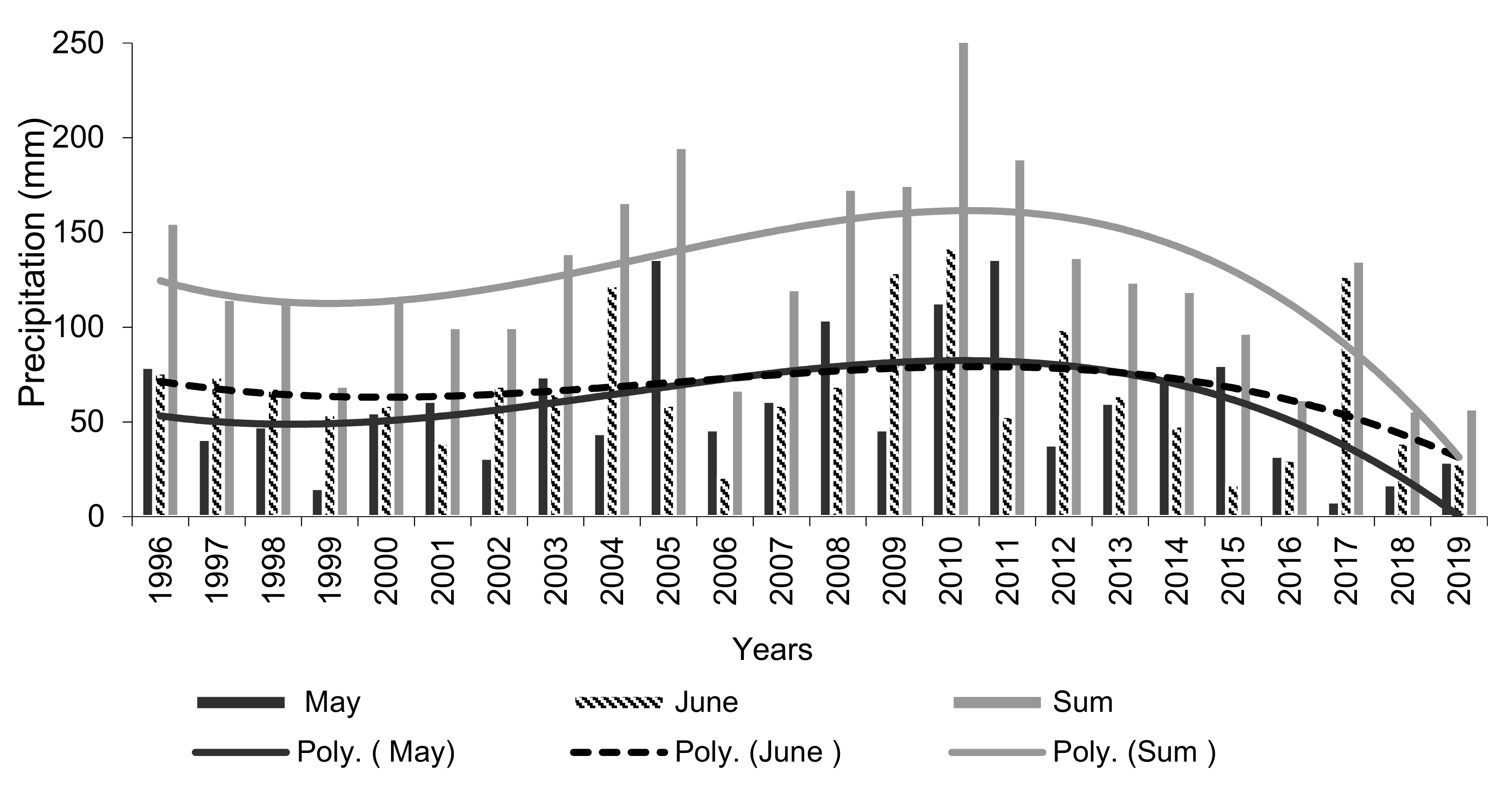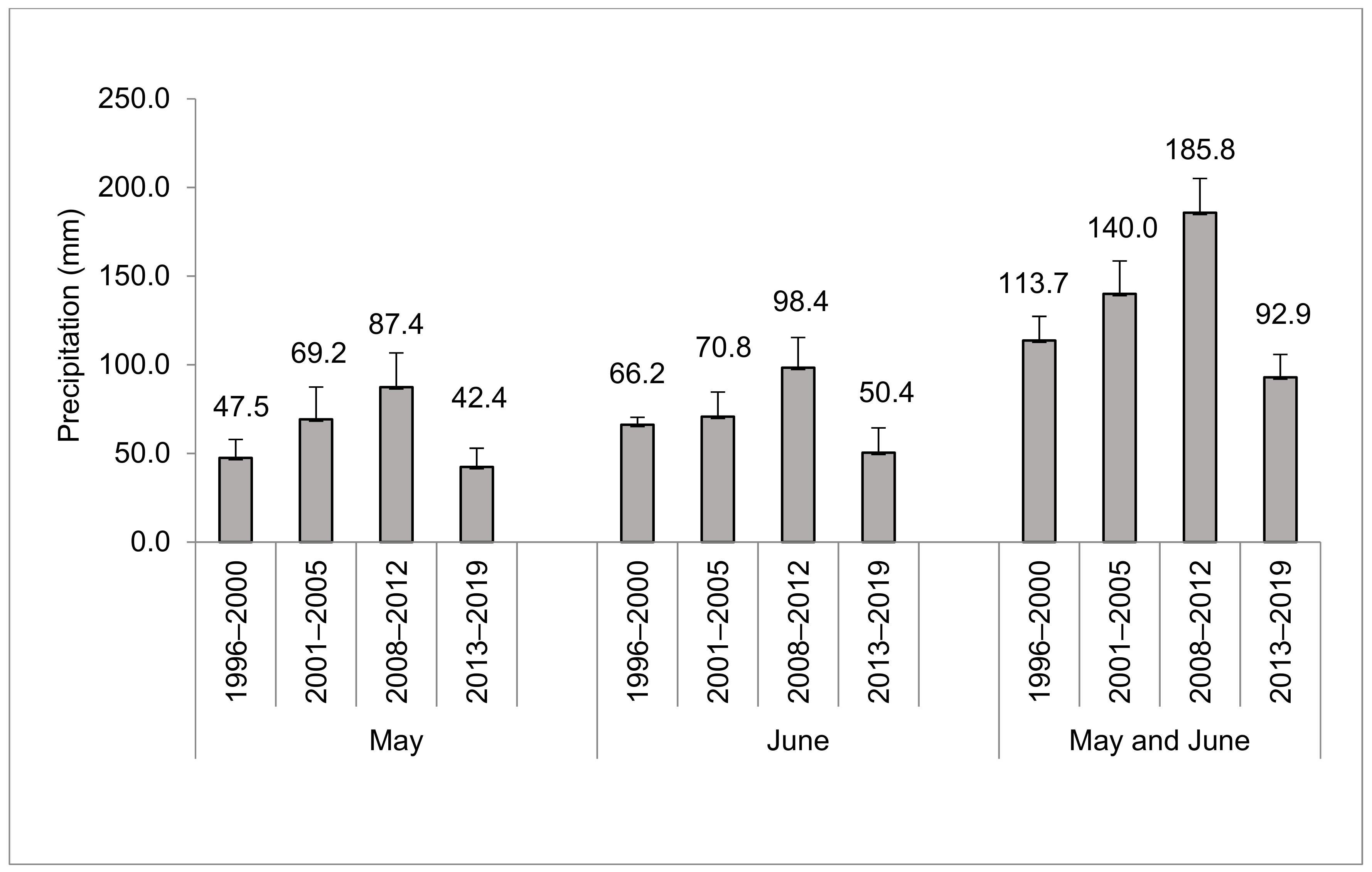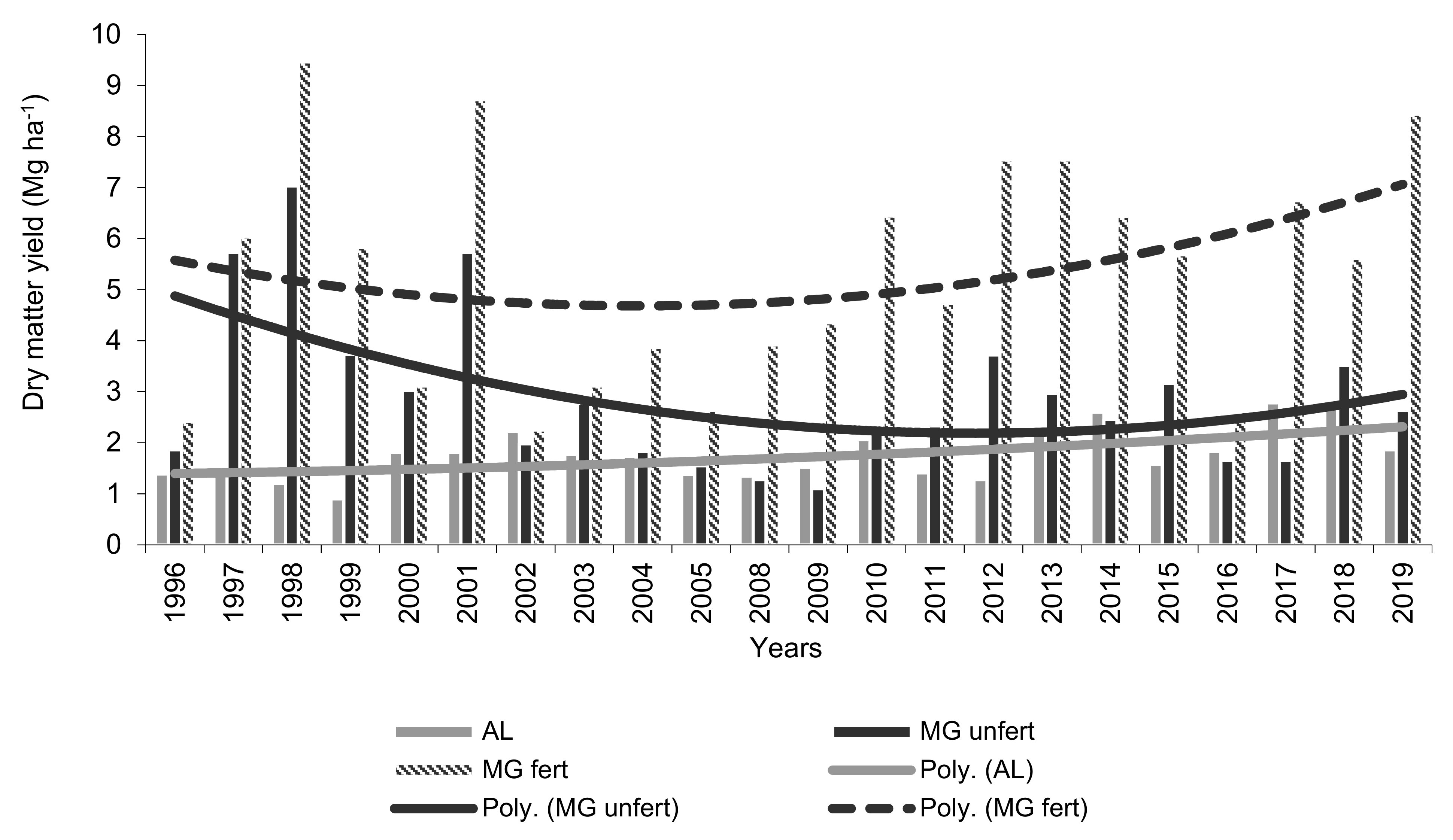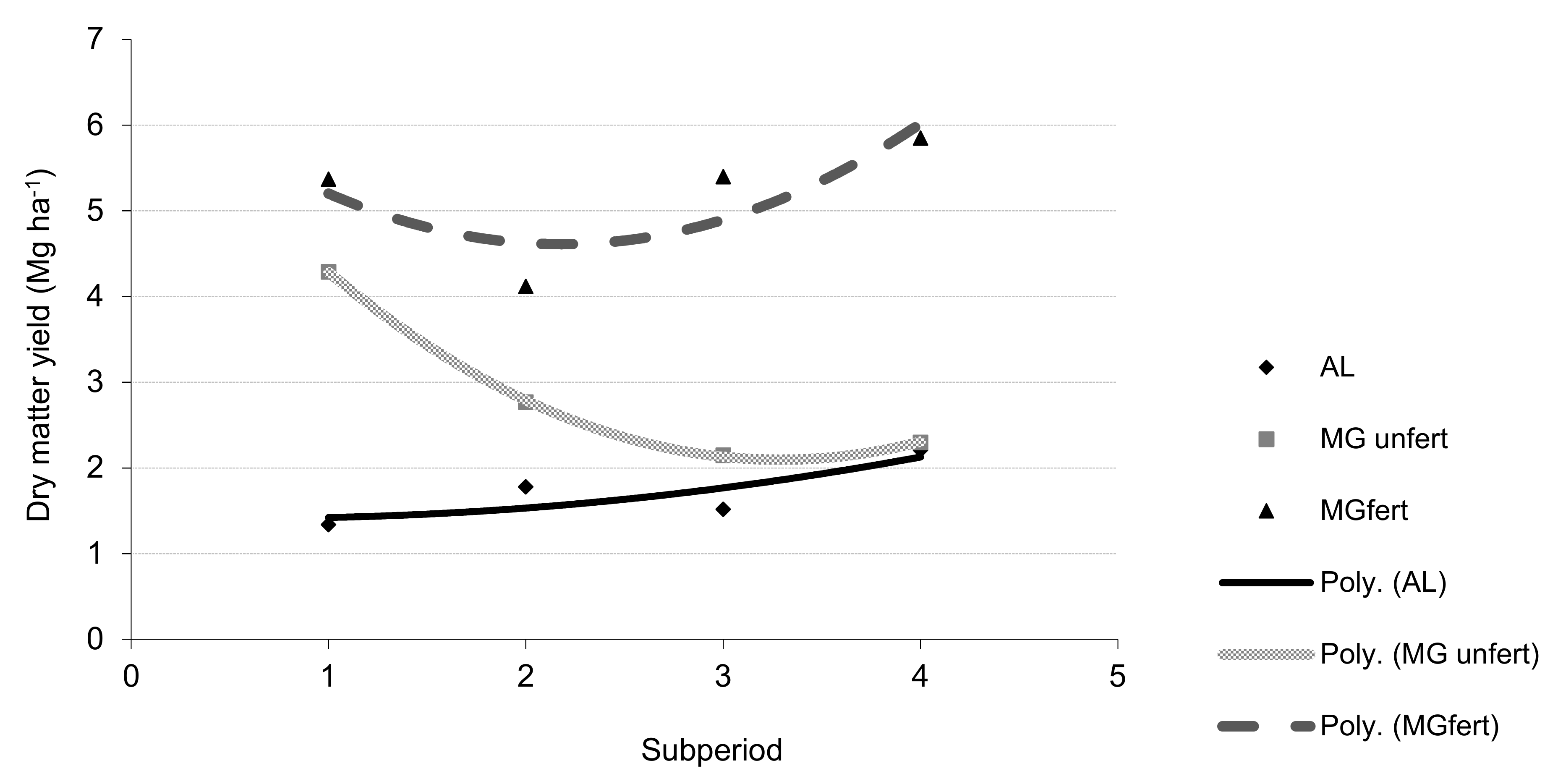Natural and Managed Grasslands Productivity during Multiyear in Ex-Arable Lands (in the Context of Climate Change)
Abstract
1. Introduction
2. Materials and Methods
2.1. Experimental Site Description
2.2. Field Investigation
2.3. Calculation of Biomass Yield
2.4. Meteorological Conditions
2.5. Soil Sampling
2.6. Laboratory Analysis
- pHKCl—by ISO 10390:2005 potentiometric method (1 mol l−1 KCl using a soil/solution ratio of 1:2.5).
- Corg—by Duma method (after dry combustion), ISO 10694:1999.
- Plant available P2O5 and K2O were extracted using 0.03 M ammonium lactate (Egner-Riehm-Domingo (A–L) method).
2.7. Statistical Analysis
3. Results
3.1. Precipitation in 1995–2019
3.2. Grassland Biomass Productivity
3.3. Organic Carbon Sequestration in Different Grassland Soils
4. Discussion
5. Conclusions
Author Contributions
Funding
Institutional Review Board Statement
Informed Consent Statement
Data Availability Statement
Acknowledgments
Conflicts of Interest
References
- Ajayi, A.E.; Horn, R. Transformation of ex-arable land to permanent grassland promotes pore rigidity and mechanical soil resilience. Ecol. Eng. 2016, 94, 592–598. [Google Scholar] [CrossRef]
- Bugalho, M.N.; Abreu, J.M.F. The multifunctional role of grasslands. In Sustainable Mediterranean Grasslands and Their Multi-Functions; Porqueddu, C., Tavares de Sousa, M.M., Eds.; Options Méditerran Eennes: Série A. Sémin Aires Méditerran Eens; n. 79; FAO: Rome, Italy, 2008; pp. 25–30. [Google Scholar]
- Valko, O.; Deák, B.; Török, P.; Kelemen, A.; Miglécz, T.; Tóth, K. Abandonment of croplands: Problem or chance for grassland restoration? Case studies from Hungary. Ecosyst. Health Sustain. 2016, 2, e01208. [Google Scholar] [CrossRef]
- Janowiak, M.; Connelly, W.J.; Dante-Wood, K.; Domke, G.M.; Giardina, C.; Kayler, Z.; Marcinkowski, K.; Ontl, T.; Rodriguez-Franco, C.; Swanston, C.; et al. Considering Forest and Grassland Carbon in Land Management; United States Department of Agriculture: Washington, DC, USA, 2017; 68p. [Google Scholar]
- Huang, L.; Liu, J.; Shao, Q.; Xu, X. Carbon sequestration by forestation across China: Past, present, and future. Renew. Sustain. Energy Rev. 2012, 16, 1291–1299. [Google Scholar] [CrossRef]
- Jia, X.; Xie, B.; Shao, M.; Zhao, C. Primary Productivity and Precipitation-Use Efficiency in Temperate Grassland in the Loess Plateau of China. PLoS ONE 2015, 10, e0135490. [Google Scholar] [CrossRef] [PubMed]
- Sabiene, N.; Kušliene, G.; Zaleckas, E. The influence of land use on soil organic carbon and nitrogen content and redox potential. Zemdirb. Agric. 2010, 97, 15–24. [Google Scholar]
- Marchetti, A.; Piccini, C.; Francaviglia, R.; Mabit, L. Spatial Distribution of Soil Organic Matter Using Geostatistics: A Key Indicator to Assess Soil Degradation Status in Central Italy. Pedosphere 2012, 22, 230–242. [Google Scholar] [CrossRef]
- Kumm, K.-I.; Hessle, A. Economic Comparison between Pasture-Based Beef Production and Afforestation of Abandoned Land in Swedish Forest Districts. Land 2020, 9, 42. [Google Scholar] [CrossRef]
- Meyfroidt, P. Trade-offs between environment and livelihoods: Bridging the global land use and food security discussions. Glob. Food Secur. 2018, 16, 9–16. [Google Scholar] [CrossRef]
- Forbord, M.; Vik, J. Food, farmers, and the future: Investigating prospects of increased food production within a national context. Land Use Policy 2017, 67, 546–557. [Google Scholar] [CrossRef]
- Rega, C.; Helming, J.; Paracchini, L.M. Environmentalism and localism in agricultural and land-use policies can maintain food production while supporting biodiversity. Findings from simulations of contrasting scenarios in the EU. Land Use 2019, 87, 103986. [Google Scholar] [CrossRef]
- Zhang, L.; Xie, Z.; Zhao, R.; Wang, Y. The impact of land use change on soil organic carbon and labile organic carbon stocks in the Longzhong region of loess Plateau. J. Arid Land 2012, 4, 241–250. [Google Scholar] [CrossRef]
- Liu, Y.; Tian, F.; Jia, P.; Zhang, J.; Hou, F.; Wu, G. Leguminous species sequester more carbon than gramineous species in cultivated grasslands of a semi-arid area. Solid Earth 2017, 8, 83–91. [Google Scholar] [CrossRef]
- Cai, A.; Feng, W.; Zhang, W.; Xu, M. Climate, soil texture, and soil types affect the contributions of fine-fraction-stabilized carbon to total soil organic carbon in different land uses across China. J. Environ. Manag. 2016, 172, 2–9. [Google Scholar] [CrossRef] [PubMed]
- Sanaullah, M.; Afzal, T.; Shahzad, T.; Wakeel, A. 2019 Carbon Sequestration for Sustainable Agriculture. In Innovations in Sustainable Agriculture; Farooq, M., Pisante, M., Eds.; Springer: Cham, Switzerland, 2019; pp. 469–500. [Google Scholar] [CrossRef]
- Ye, X.; Tang, S.; Cornwell, W.K.; Gao, S.; Huang, Z.; Dong, M.; Cornelissen, J.H.C. Impact of land-use on carbon storage as dependent on soil texture: Evidence from a desertified dryland using repeated paired sampling design. J. Environ. Manag. 2015, 150, 489–498. [Google Scholar] [CrossRef] [PubMed]
- Gbarrón-Galeote, M.A.; Trigal, S.; Wesemael, S.T.B. Effect of land abandonment on soil organic carbon fractions along a Mediterranean precipitation gradient. Geoderma 2015, 249–250, 69–78. [Google Scholar] [CrossRef]
- Kämpf, I.; Hölzel, N.; Störrle, M.; Broll, M.; Kiehl, K. Potential of temperate agricultural soils for carbon sequestration: A meta-analysis of land-use effects. Sci. Total Environ. 2016, 566–567, 428–435. [Google Scholar] [CrossRef]
- Ogle, S.M.; Breidt, F.J.; Paustian, K. Agricultural management impacts on soil organic carbon storage under moist and dry climatic conditions of temperate and tropical regions. Biogeochemistry 2005, 72, 87–121. [Google Scholar] [CrossRef]
- Park, T.; Ganguly, S.; Tømmervik, H.; Euskirchen, E.S.; Høgda, K.-A.; Karlsen, S.R.; Brovkin, V.; Nemani, R.R.; Myneni, R.R. Changes in growing season duration and productivity of northern vegetation inferred from long-term remote sensing data. Environ. Res. Lett. 2016, 11, 084001. [Google Scholar] [CrossRef]
- Dolferus, R. To grow or not to grow: A stressful decision for plants. Plant Sci. 2014, 229, 247–261. [Google Scholar] [CrossRef]
- Marchese, D.; Reynolds, E.; Bates, M.E.; Morgan, H.; Clark, S.S.; Linkov, I. Resilience and sustainability: Similarities and differences in environmental management applications. Sci. Total Environ. 2018, 613–614, 1275–1283. [Google Scholar] [CrossRef] [PubMed]
- Brevik, E.C. The Potential Impact of Climate Change on Soil Properties and Processes and Corresponding Influence on Food Security. Agriculture 2013, 39, 398–417. [Google Scholar] [CrossRef]
- Peigné, J.; Vian, J.-F.; Payet, V.; Saby, N.P.A. Soil fertility after 10 years of conservation tillage in organic farming. Soil Tillage Res. 2018, 175, 194–204. [Google Scholar] [CrossRef]
- Ghahramani, A.; Howden, S.M.; del Prado, A.; Thomas, D.T.; Moore, A.D.; Ji, B.; Ates, S. Climate Change Impact, Adaptation, and Mitigation in Temperate Grazing Systems: A review. Sustainability 2019, 11, 7224. [Google Scholar] [CrossRef]
- FAO. Guidelines for Soil Description, 4th ed.; Food and Agriculture Organization of the United Nations: Rome, Italy, 2006; 97p. [Google Scholar]
- FAO. International Soil Classification System for Naming Soils and Creating Legends for Soil Maps; WRB 2014, Update 2015; World Reference Base for Soil Resources 2014, Update 2015; Food and Agriculture Organization of the United Nations: Rome, Italy, 2015; p. 192. [Google Scholar]
- Daugeliene, N. Grassland Management on Acid Soils; Publishing House “Lututė”: Kaunas, Lithuania, 2002; 261p. [Google Scholar]
- McKenzie, N.J.; Jacquier, D.J.; Isbell, R.F.; Brown, K.L. Australian Soils and Landscapes an Illustrated Compendium; CSIRO Publishing: Collingwood, Australia, 2004; Available online: http://www.publish.csiro.au/pid/3821.htm (accessed on 4 March 2021).
- Poeplau, C.; Vos, C.; Don, A. Soil organic carbon stocks are systematically overestimated by misuse of the parameters bulk density and rock fragment content. Soil 2017, 3, 61–66. [Google Scholar] [CrossRef]
- Clewer, A.G.; Scarisbrick, D.H. Practical Statistics and Experimental Design for Plant and Crop Science; Wiley & Sons: Hoboken, NJ, USA, 2001; 346p. [Google Scholar]
- Galvonaite, A.; Misiuniene, M.; Valiukas, D.; Buitkuviene, M.S. Lithuanian Climate; Lithuanian Hydrometeorological Service: Vilnius, Lithuania, 2007; 207p. [Google Scholar]
- Dong, S.; Shang, Z.; Gao, J.; Boone, R.B. Enhancing sustainability of grassland ecosystems through ecological restoration and grazing management in an era of climate change on Qinghai-Tibetan Plateau. Agric. Ecosyst. Environ. 2020, 287, 106684. [Google Scholar] [CrossRef]
- Craine, J.M.; Nippert, J.B.; Elmore, A.J.; Skibbe, A.M.; Hutchinson, S.L.; Brunsell, N.A. Timing of climate variability and grassland productivity. Proc. Natl. Acad. Sci. USA 2012, 109, 3401–3405. [Google Scholar] [CrossRef] [PubMed]
- Petrie, M.D.; Peters, D.P.C.; Yao, J.; Blair, J.M.; Burruss, N.D.; Collins, S.L.; Derner, J.D.; Gherardi, L.A.; Hendrickson, J.R.; Sala, O.E.; et al. Regional grassland productivity responses to precipitation during multiyear above and below average rainfall periods. Glob. Chang. Biol. 2018, 24, 1935–1951. [Google Scholar] [CrossRef]
- Evrendilek, F.; Celik, I.; Kilic, S. Changes in soil organic carbon and other physical soil properties along adjacent Mediterranean forest, grassland, and cropland ecosystems in Turkey. J. Arid Environ. 2004, 59, 743–752. [Google Scholar] [CrossRef]
- Wu, G.L.; Liu, Y.; Fang, N.F.; Deng, L.; Shi, Z.H. Soil physical properties response to grassland conversion from cropland on the semi-arid area. Ecohydrology 2016, 9, 1471–1479. [Google Scholar] [CrossRef]
- Burdukovskii, M.; Kiseleva, I.; Perepelkina, P.; Kosheleva, Y. Impact of different fallow durations on soil aggregate structure and humus status parameters. Soil Water Res. 2020, 15, 1–8. [Google Scholar] [CrossRef]
- Wertebach, T.M.; Hölzel, N.; Kämpf, I.; Yurtaev, A.; Tupitsin, S.; Kiehl, K.; Kamp, J.; Kleinebecker, T. Soil carbon sequestration due to post-Soviet cropland, abandonment: Estimates from a large scale soil organic carbon field inventory. Glob. Chang. Biol. 2017, 23, 3729–3741. [Google Scholar] [CrossRef]
- Ovsepyan, L.; Kurganova, I.; Lopes de Gerenyu, V.; Kuzyakov, J. Recovery of organic matter and microbial biomass after abandonment of degraded agricultural soils: The influence of climate. Land Degrad. Dev. 2019, 30, 1861–1874. [Google Scholar] [CrossRef]
- Yang, Y.; Tilman, D.; Furey, G.; Leman, C. Soil carbon sequestration accelerated by restoration of grassland biodiversity. Nat. Commun. 2019, 10, 718. [Google Scholar] [CrossRef]
- Oelmann, Y.; Brauckmann, H.-J.; Schreiber, K.-F.; Broll, G. 40 years of succession or mulching of abandoned grassland affect phosphorus fractions in soil. Agric. Ecosyst. Environ. 2017, 237, 66–74. [Google Scholar] [CrossRef]
- Tripolskaja, L.; Mašauskas, V.; Adomaitis, V.; Karčauskienė, D.; Vaisvila, Z. Management of Agroecosystem Components. Results of Long-Term Agrochemical Experiments; Lithuanian Research Centre for Agriculture and Forestry: Akademija Kedainiai, Lithuania, 2010; 267p. [Google Scholar]
- Kizekova, M.; Feoli, E.; Parente, G.; Kanianska, R. Analysis of the effects of mineral fertilization on species diversity and yield of permanent grasslands: Revisited data to mediate economic and environmental needs. Commun. Ecol. 2017, 18, 295–304. [Google Scholar] [CrossRef]
- Čop, J. Soil acidification and liming in grassland production and grassland soil fertility in Slovenia. Acta Agric. Slov. 2014, 103, 15–25. [Google Scholar] [CrossRef]




| Measured Parameters | Abandoned Land | Managed Grassland Unfertilized | Managed Grassland Fertilized | |||
|---|---|---|---|---|---|---|
| 1995 | 2018 | 1995 | 2018 | 1995 | 2018 | |
| pHKCl | 6.0A | 5.8Aa | 6.8B | 6.0Aa | 6.8A | 5.6Aa |
| Available P2O5 mg kg−1 | 157B | 150Ab | 177B | 77A | 177A | 264Ac |
| Available K2O mg kg−1 | 170B | 144Aa | 174B | 70Ab | 174A | 166Aa |
| Land Use | Average ± SE 1996–2019 | Min | Max | Median | Variation (%) | Rainfall Amount in May–June (mm) | ||
|---|---|---|---|---|---|---|---|---|
| <100 | 100–150 | >150 | ||||||
| AL | 1.76 ± 0.105 | 0.90 | 2.78 | 1.75 | 33.9 | 1.77 ± 0.284 | 1.90 ± 0.170 | 1.55 ± 0.098 |
| MGunfert | 2.91 ± 0.327 | 1.10 | 7.03 | 2.54 | 42.6 | 2.57 ± 0.411 | 3.71 ± 0.576 | 1.76 ± 0.182 |
| MGfert | 5.33 ± 0.469 | 2.25 | 9.46 | 5.65 | 27.8 | 5.21 ± 0.817 | 6.09 ± 0.785 | 4.05 ± 0.511 |
| Land Use | Thickness of A Horizon (m) | Corg (mg kg−1) | Corg (Mg ha−1) | Corg (Mg ha−1 year−1) | |||
|---|---|---|---|---|---|---|---|
| 1995 | 2018 | 1995 | 2018 | 1995 | 2018 | ||
| AL | 0.28 | 0.34 | 10.2A | 10.4Ba | 38.0A | 48.5Ba | 0.455 |
| MGunfert | 0.28 | 0.30 | 9.9A | 10.7Ba | 39.1A | 44.0Ba | 0.212 |
| MGfert | 0.28 | 0.32 | 9.9A | 11.3Ba | 40.2A | 47.6Ba | 0.321 |
Publisher’s Note: MDPI stays neutral with regard to jurisdictional claims in published maps and institutional affiliations. |
© 2021 by the authors. Licensee MDPI, Basel, Switzerland. This article is an open access article distributed under the terms and conditions of the Creative Commons Attribution (CC BY) license (http://creativecommons.org/licenses/by/4.0/).
Share and Cite
Tripolskaja, L.; Kazlauskaite-Jadzevice, A.; Baliuckas, V.; Razukas, A. Natural and Managed Grasslands Productivity during Multiyear in Ex-Arable Lands (in the Context of Climate Change). Agriculture 2021, 11, 215. https://doi.org/10.3390/agriculture11030215
Tripolskaja L, Kazlauskaite-Jadzevice A, Baliuckas V, Razukas A. Natural and Managed Grasslands Productivity during Multiyear in Ex-Arable Lands (in the Context of Climate Change). Agriculture. 2021; 11(3):215. https://doi.org/10.3390/agriculture11030215
Chicago/Turabian StyleTripolskaja, Liudmila, Asta Kazlauskaite-Jadzevice, Virgilijus Baliuckas, and Almantas Razukas. 2021. "Natural and Managed Grasslands Productivity during Multiyear in Ex-Arable Lands (in the Context of Climate Change)" Agriculture 11, no. 3: 215. https://doi.org/10.3390/agriculture11030215
APA StyleTripolskaja, L., Kazlauskaite-Jadzevice, A., Baliuckas, V., & Razukas, A. (2021). Natural and Managed Grasslands Productivity during Multiyear in Ex-Arable Lands (in the Context of Climate Change). Agriculture, 11(3), 215. https://doi.org/10.3390/agriculture11030215






